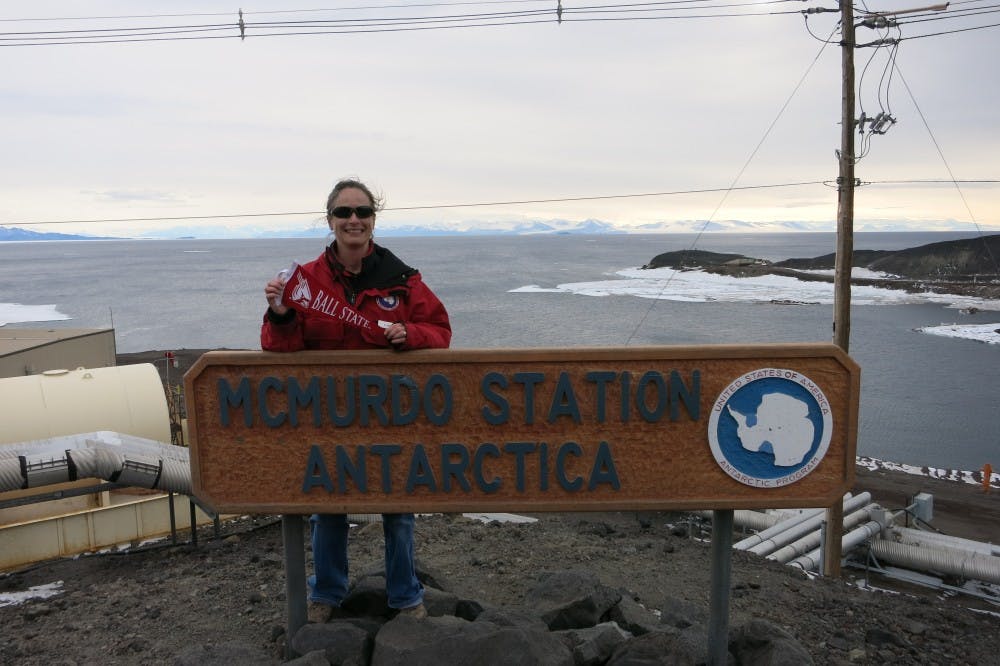Antarctica Facts
- Antarctica was first established as a continent in 1840.
- It's the fifth largest continent, only bigger than Australia and Europe.
- East Antarctica is the coldest region of the continent.
- It has no indigenous inhabitants.
Source: The Central Intelligence Agency's World Factbook
It’s the colors that Carolyn Dowling misses when she visits the loneliest continent on Earth.
In Antarctica “there’s nothing,” she said — just a repeating landscape of brown and white. But that hasn’t ever stopped the Ball State geology professor from going.
She spent 90 days this past winter contributing to a research team who studied in the McMurdo Valleys, an area that is part of the 1 to 2 percent of Antarctica not completely covered in ice.
“It’s such an alien place to be. But there’s something that just gets in your blood and you just want to go down, I don’t know why,” she said.
She’s visited twice before on different research projects before her most recent trip from December to February.
W. Berry Lyons, Dowling’s post-doctoral director at Ohio State University, connected her to the project, which was part of the McMurdo Dry Valleys Long-Term Ecological Research Program.
The National Science Research Foundation funded Dowling and her team. They focused their research on climate change going on in the area, as well as the effects human life have on natural areas. Antarctica has a very small human footprint.
Much of the work Dowling does focuses on analyzing sediment samples to figure out chemical weather — the effects of water on sediments depending on their age.
Dowling spent most of the trip staying in a dorm-style bunker, but when she was out in the field collecting samples multiple days in a row, she and the team slept outside in tents.
“I needed the warmer sleeping bag — women usually sleep colder than men, and I definitely fall into that stereotype,” she said.
When out in the field, Dowling collected samples for her research that she would process and analyze in the lab at McMurdo Station.
Alongside research, fieldwork also meant unplugging from the world back home.
“They send out board games to the field depending on where you are, because there’s limited Internet,” she said. “You can’t do Hulu, you can’t do Netflix, so you play games. You knit, you exercise, there are many things you can do, but if you are used to being connected to the world, it is very bizarre.”
But Dowling did have a furry friend to keep her company during the trip. Her husband gave her a photo album and a stuffed Stitch doll from the movie “Lilo and Stitch.”
“I have a whole album on Stitch: leaving, in the airport. … Stitch was with me a lot,” she said.
Despite the extreme weather, Dowling said the cold did not bother her as much as the change in sun exposure.
“The 24-hour daylight really affected my sleep,” she said.
Dowling’s research is ongoing with no results yet. Her instruments reside at Ohio State, and she was taking several trips back and forth between Muncie and Columbus, Ind., before the semester began.
Sarah Rees, a chemistry major, has been assisting Dowling with the processing of samples collected on the trip. She’s gained valuable lab experience from the opportunity, but Dowling has inspired her as well.
“Working with Dr. Dowling on this project has drastically changed my opinion on whether or not I would like to spend months in below-freezing temperatures,” she said. “To be able to study in a place that is almost completely untouched is invaluable to gaining a full understanding of Earth’s processes.”
The first place Dowling arrived after leaving Antarctica was New Zealand. The monotonous whites and browns of Antarctica became the blue and gray skies of Oceania.
“My first plant I saw was a weed in the sidewalk, and I was like, ‘Yeah, look at that, it’s green,’” she said. “It was vegetation — you really don’t understand how much you miss it.”
Dowling still plans to return to Antarctica in the future. She’s already planning to submit research proposals to the National Science Foundation in April.
|
Antarctica Facts • Antarctica was first established as a continent in 1840. • It's the fifth largest continent—only bigger than Australia and Europe. • East Antarctica is the coldest region of the continent. • It has no indigenous inhabitants. Source: the Central Intelligence Agency's World Facebook |





